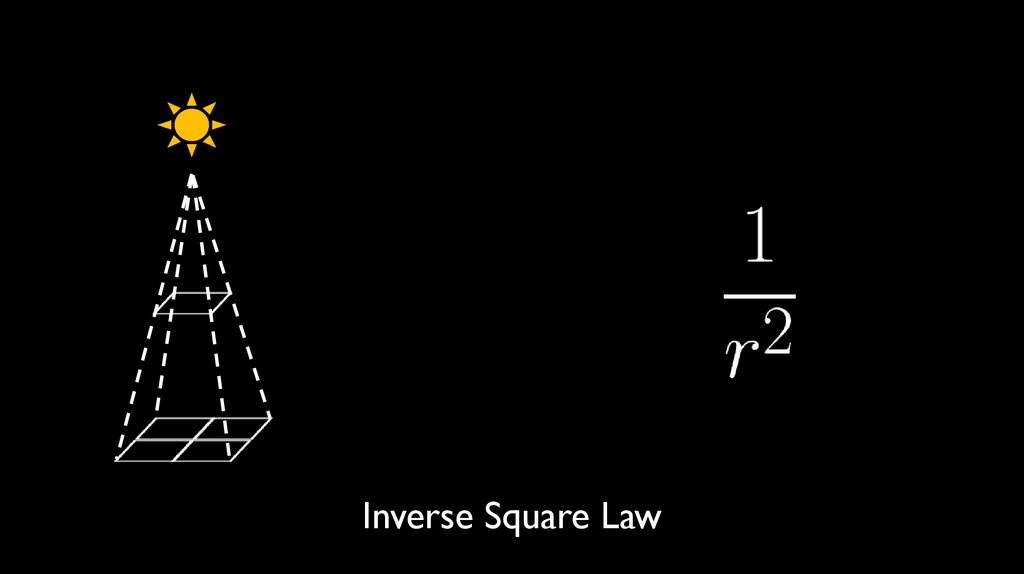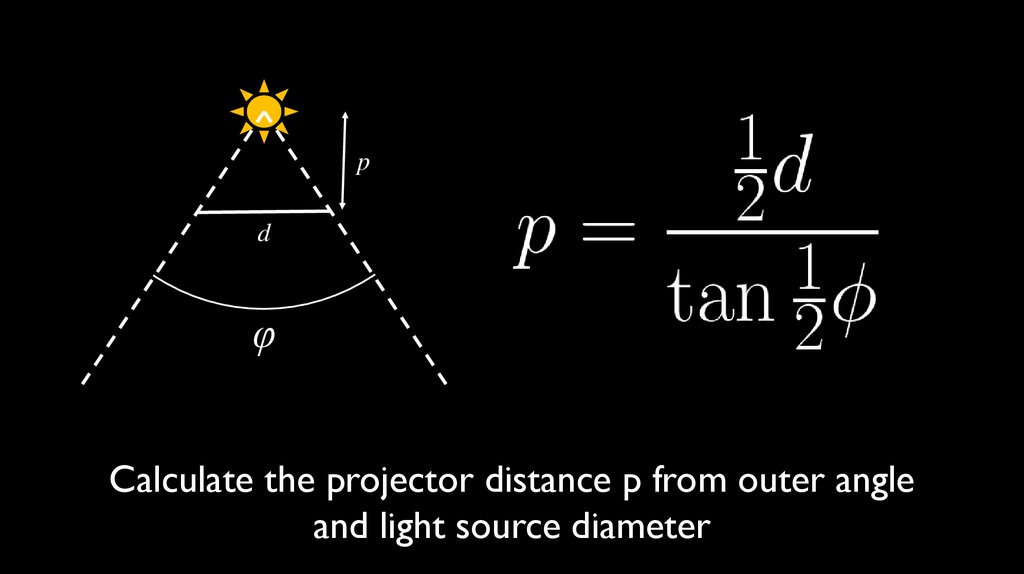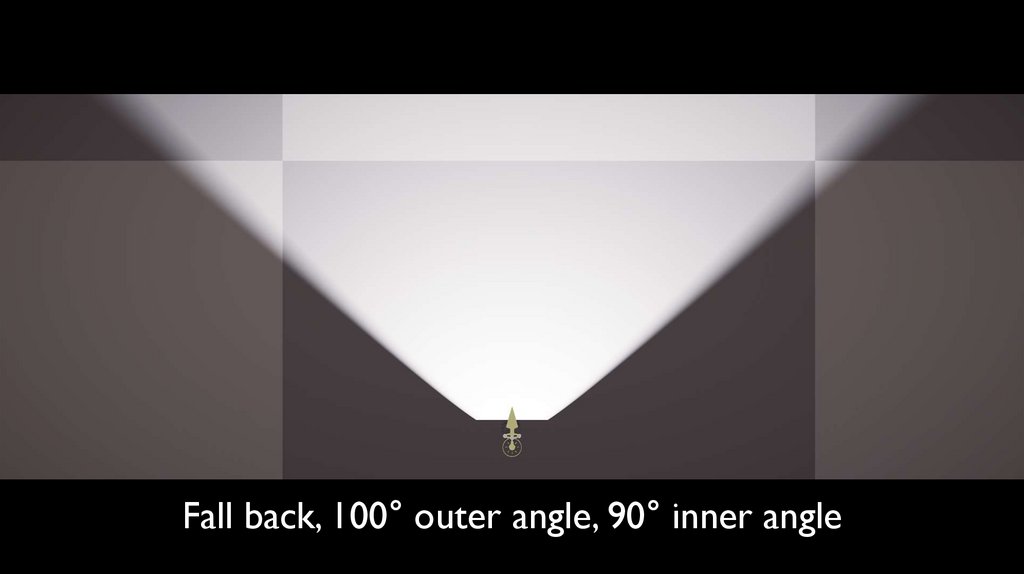Похожие презентации:
A Journey Through Implementing Multiscattering BRDFs and Area Lights
1.
2.
A Journey Through ImplementingMultiscattering BRDFs & Area Lights
Stephen McAuley
3.
4.
[Heitz16a]5.
[Kulla17]6.
If the energy reflected for a given BRDF f and aviewing direction is:
Then find a multiscattering BRDF fms such that energy
is preserved:
7.
The following BRDF fits that equation:Where:
8.
In fact, that only holds for 100% reflective microfacets.Energy is lost between each bounce.
Sum the loss and scale fms by:
Where:
9.
Need to Calculate:For a given roughness
• 1-E(μ)
• Eavg
• Favg
10.
std::fstream isotropicEnergyFile;isotropicEnergyFile.open("isotropic_reflected_energy.csv", std::ios_base::out);
for (int j = 0; j < NumSmoothnessSamples; ++j)
{
float s = float(j) / float(NumSmoothnessSamples - 1);
float a = GGXAlphaFromSmoothness(s);
for (int i = 0; i < NumDirectionSamples; ++i)
{
float mu = float(i) / float(NumDirectionSamples - 1);
float isotropicReflectedEnergy = IsotropicReflectedEnergy(mu, a);
char outputLine[128];
sprintf_s(outputLine, sizeof(outputLine), "%12.10f, ", 1.0f - isotropicReflectedEnergy);
isotropicEnergyFile.write(outputLine, strlen(outputLine));
}
isotropicEnergyFile.write("\n", 1);
}
isotropicEnergyFile.close();
1-E(μ)
11.
float AverageEnergy(float alpha){
static const int NumBRDFSamples = 16384;
float averageEnergy = 0.0f;
for (int i = 0; i < NumBRDFSamples; ++i)
{
float u, v;
GetQuasiRandomSequence(i, u, v);
float3 h = UniformSampleHemisphere(u, v);
float isotropicReflectedEnergy = IsotropicReflectedEnergy(h.z, alpha);
averageEnergy += isotropicReflectedEnergy * h.z;
}
averageEnergy *= 2.0f;
averageEnergy /= NumBRDFSamples;
return averageEnergy;
}
Eavg
12.
1-E(μ)Eavg
float AverageEnergy(float smoothness)
{
float r = -0.0761947f - 0.383026f * smoothness;
r = 1.04997f + smoothness * r;
r = 0.409255f + smoothness * r;
return min(0.999f, r);
}
Favg
float3 AverageFresnel(float3 specularColor)
{
return specularColor + (1.0f - specularColor) * (1.0f / 21.0f);
}
13.
DielectricsMultiscattering Specular Off
14.
DielectricsMultiscattering Specular On
15.
MetalsMultiscattering Specular Off
16.
MetalsMultiscattering Specular On
17.
Multiscattering Diffuse18.
Goals:Improvements to Lambertian diffuse
1.
2.
3.
4.
Multiscattering is taken into account
Diffuse reacts to surface roughness
Diffuse depends on the distribution of normals
Diffuse and specular are energy conserving
19.
Material Advances in Call of Duty: WWII [Chan18]20.
21.
float MultiScatteringDiffuseBRDF(float lDotH, float nDotL, float nDotV,float nDotH, float smoothness)
{
// Burley to CoD gloss reparametrization
//
CoD
: alpha2 = 2 / (1 + 2^(18g))
//
Burley: alpha2 = (1 - g)^4
float g = saturate(0.18455f * log(2.0f / pow(1.0f - smoothness, 4.0f) - 1.0f));
float f0 = lDotH + pow(1.0f – lDotH, 5.0f);
float f1 = (1.0f - 0.75f * pow(1.0f – nDotL, 5.0f))
* (1.0f - 0.75f * pow(1.0f – nDotV, 5.0f));
float t = saturate(2.2f * g - 0.5f);
float fd = f0 + (f1 - f0) * t;
float fb = ((34.5f * g - 59.0f) * g + 24.5f) * lDotH
* exp2(-max(73.2f * g - 21.2f, 8.9f) * sqrt(nDotH));
return fd + fb;
}
22.
float MultiScatteringDiffuseBRDF(float lDotH, float nDotL, float nDotV,float nDotH, float smoothness)
{
// Burley to CoD gloss reparametrization
//
CoD
: alpha2 = 2 / (1 + 2^(18g))
//
Burley: alpha2 = (1 - g)^4
float g = saturate(0.18455f * log(2.0f / pow(1.0f - smoothness, 4.0f) - 1.0f));
float f0 = lDotH + pow5(1.0f - lDotH);
float f1 = (1.0f - 0.75f * pow5(1.0f - nDotL))
* (1.0f - 0.75f * pow5(1.0f - nDotV));
float t = saturate(2.2f * g - 0.5f);
float fd = f0 + (f1 - f0) * t;
float fb = ((34.5f * g - 59.0f) * g + 24.5f) * lDotH
* exp2(-max(73.2f * g - 21.2f, 8.9f) * sqrt(nDotH));
return fd + fb;
}
23.
Lambert Diffuse24.
Multiscattering Diffuse25.
Difference x826.
“Are we there yet?”27.
Surface TypeSkin
Diffuse BRDF
Specular BRDF
GGX
Hair
Pre-Integrated Subsurface Scattering
(Lambert)
Lambert
Car Paint
Lambert
Two GGX lobes
(Top layer and bottom layer)
Cloth
Lambert
Translucent
Two wrapped Lambert lobes
(Front and back)
Lambert
Ashikhmin Cloth +
Disney Sheen
GGX
Default
Modified Marschner
GGX
28.
Light TypeDiffuse Evaluation
Specular Evaluation
Direct
Analytic
Analytic
Indirect
Spherical Harmonics
Screen-Space Reflections
Pre-Integrated Cube Maps
Pre-Integrated BRDF
29.
Problems:1.
2.
3.
4.
5.
No multiscattering indirect specular
No multiscattering specular on hair
No multiscattering indirect diffuse
No multiscattering diffuse on skin
No multiscattering wrapped diffuse
30.
Problems:1.
2.
3.
4.
5.
No multiscattering indirect specular
No multiscattering wrapped diffuse
No multiscattering diffuse on skin
No multiscattering indirect diffuse
No multiscattering specular on hair
31.
Indirect specular32.
Split-Sum Approximation [Karis13]33.
Environment Map BRDF34.
Environment Map BRDF35.
Multiscattering Environment Map BRDF36.
Multiscattering Environment Map BRDF37.
Multiscattering Environment Map BRDF38.
Multiscattering Environment Map BRDF39.
Environment Map BRDF40.
Multiscattering Environment Map BRDF41.
[FdezAgüera19]42.
The paper observes that the single-scattering energy is in fact thesum of the red and green channels in our environment BRDF:
It also observes that Eavg can be approximated as E(μ)
43.
Given that Favg can be calculated analytically, and multiplyscattered light is diffuse, we get the following formula:float2
float
float
float
float
float
float
FssEss
Ess
Ems
Favg
Fms
Lss
Lms
=
=
=
=
=
=
=
envBRDF.x + F0 * envBRDF.y;
envBRDF.x + envBRDF.y;
1.0f - Ess;
F0 + (1.0f / 21.0f) * (1.0f - F0);
FssEss * Favg / (1.0f - Favg * (1.0f - Ess));
FssEss * radiance;
Fms * Ems * irradiance;
return Lss + Lms;
44.
Given that Favg can be calculated analytically, and multiplyscattered light is diffuse, we get the following formula:float2
float
float
float
float
float
float
FssEss
Ess
Ems
Favg
Fms
Lss
Lms
=
=
=
=
=
=
=
envBRDF.x + F0 * envBRDF.y;
envBRDF.x + envBRDF.y;
1.0f - Ess;
F0 + (1.0f / 21.0f) * (1.0f - F0);
FssEss * Favg / (1.0f - Favg * (1.0f - Ess));
FssEss * radiance;
Fms * Ems * radiance;
return Lss + Lms;
45.
Single Scattering46.
Fdez-Agüera47.
Approximation to Fdez-Agüera48.
This gives a multiscattering formula for the environment BRDF as:49.
[Turquin19]50.
Approximation to Fdez-Agüera51.
Turquin52.
Multiscattered Specular [Kulla17]53.
Approximation to Fdez-Agüera54.
Turquin55.
56.
57.
58.
Problems:1.
2.
3.
4.
5.
No multiscattering indirect specular
No multiscattering specular on hair
No multiscattering indirect diffuse
No multiscattering diffuse on skin
No multiscattering wrapped diffuse
59.
60.
Problems:1.
2.
3.
4.
5.
No multiscattering indirect specular
No multiscattering specular on hair
No multiscattering indirect diffuse
No multiscattering diffuse on skin
No multiscattering wrapped diffuse
61.
Area Lights62.
Goals:1. Improve cinematic lighting:
Softer light falloffs
2. More realistic specular response:
• Broader, more visible highlights
• Artists authoring smoother materials
63.
[Heitz16b]64.
Why LTCs?1.
2.
3.
4.
Fast to implement
Full source code and demos available
Flexibility in performance and light types
Performant and robust
65.
A clamped cosine distribution can beanalytically integrated over polygonal
shapes
66.
We can linearly transform thisdistribution to approximate BRDFs
67.
Integrating a polygon over an LTCbecomes integrating a polygon over the
analytically solvable clamped cosine
distribution
68.
Q. LTCs always integrate to 1, but what about the actualmagnitude of the BRDF?
A. Integrate the BRDF and store the magnitude in a LUT.
Separate out Fresnel so we can take F0 into account.
[Hill16]
69.
Apply Schlick’s approximation to Fresnel to get two components:[Hill2016]
70.
Implementation:1. Offline, generate look up tables:
Inverse matrix transform
Magnitude and Fresnel
Inverse Matrix LUT
2. In the shader:
Calculate area light coordinates
Apply inverse transform
Integrate polygon over sphere with a
clamped cosine distribution
Scale by BRDF magnitude and Fresnel
Magnitude and
Fresnel LUT
71.
Point Light72.
Quad Light73.
Disk Light74.
“Are we there yet?”75.
Surface TypeSkin
Diffuse BRDF
Specular BRDF
GGX
Hair
Pre-Integrated Subsurface Scattering
(Lambert)
Lambert
Car Paint
Lambert
Two GGX lobes
(Top layer and bottom layer)
Cloth
Lambert
Translucent
Two wrapped Lambert lobes
(Front and back)
Lambert
Ashikhmin Cloth + Disney
Sheen
GGX
Default
Modified Marschner
GGX
76.
Surface TypeDiffuse BRDF
Specular BRDF
Skin
Pre-Integrated Subsurface Scattering
(Lambert)
GGX + Multiscattering Lobe
Hair
Multiscattering Diffuse
Modified Marschner + ???
Car Paint
Multiscattering Diffuse
Two GGX
+ Multiscattering Lobes
(Top layer and bottom layer)
Cloth
Multiscattering Diffuse
Translucent
Two wrapped Lambert lobes
(Front and back)
Ashikhmin Cloth + Disney
Sheen
GGX + Multiscattering Lobe
Default
Multiscattering Diffuse
GGX + Multiscattering Lobe
77.
Light TypeDiffuse Evaluation
Specular Evaluation
Area
Analytic with
Pre-Integrated BRDF
Analytic with
Pre-Integrated BRDF
Direct
Analytic
Analytic
Indirect
Spherical Harmonics
Screen-Space Reflections
Pre-Integrated Cube Maps
Pre-Integrated BRDF
78.
Problems:1.
2.
3.
4.
5.
6.
No implementation for cloth
No implementation for multiscattering diffuse
No implementation for multiscattering specular
How to combine LTCs with wrapped diffuse
How to combine LTCs with pre-integrated skin
scattering
No implementation of Marschner approximation
for hair
79.
Source code available!https://github.com/selfshadow/ltc_code
80.
Problems:1.
2.
3.
4.
5.
6.
No implementation for cloth
No implementation for multiscattering diffuse
No implementation for multiscattering specular
How to combine LTCs with wrapped diffuse
How to combine LTCs with pre-integrated skin
scattering
No implementation of Marschner approximation
for hair
81.
Inverse Matrix LUTMagnitude and
Fresnel LUT
LTCs for Multiscattering Diffuse
82.
Lambert Diffuse83.
Multiscattering Diffuse84.
Inverse Matrix LUTMagnitude and
Fresnel LUT
LTCs for Ashikhmin Cloth [Ashikhmin00]
85.
Ashikhmin Cloth: Point Light86.
Ashikhmin Cloth: Area Light87.
Disney Sheen [Burley12]88.
Lambert DiffuseX
Magnitude and
Fresnel LUT for
Multiscattering
Diffuse
89.
Disney Sheen: Point Light90.
Disney Sheen: Area Light91.
Problems:1.
2.
3.
4.
5.
6.
No implementation for cloth
No implementation for multiscattering diffuse
No implementation for multiscattering specular
How to combine LTCs with wrapped diffuse
How to combine LTCs with pre-integrated skin
scattering
No implementation of Marschner approximation
for hair
92.
LTC magnitude and Fresnel relies on a linear dependency on F0:But our multiscattering BRDF has a non-linear dependency:
93.
[FdezAgüera19]94.
We have a formula for a multiscattering BRDF:E(μ) is the red channel in our
magnitude and Fresnel LUT:
95.
[Turquin19]96.
Single Scattering Specular97.
Approximation to Fdez-Agüera98.
Turquin99.
Problems:1.
2.
3.
4.
5.
6.
No implementation for cloth
No implementation for multiscattering diffuse
No implementation for multiscattering specular
How to combine LTCs with wrapped diffuse
How to combine LTCs with pre-integrated skin
scattering
No implementation of Marschner approximation
for hair
100.
Wrapped Lambertian Diffuse:w=0
w = 0.5
w = 1.0
101.
Rotate the normal towards the light102.
Axis:Angle:
Axis-angle rotation
103.
Axis:Sin Angle:
Axis-angle rotation
104.
float3 WrappedNormal(const float3 N, const float3 L, const float w){
float cosTheta = dot(N, L);
float wrappedCosTheta = saturate((cosTheta + w) / (1 + w));
float sinMaximumAngleChange = w;
float sinMinimumAngleChange = 0.0f;
float sinPhi = lerp(sinMaximumAngleChange, sinMinimumAngleChange, wrappedCosTheta);
float cosPhi = sqrt(1.0f - sinPhi * sinPhi);
return normalize(cosPhi * N + sinPhi * cross(cross(N, L), N));
}
Axis-angle rotation
105.
Wrapping the lighting around the sphere adds energy:w=0
w = 0.5
w = 1.0
106.
Surface area of spherical cap107.
Surface area of the extent of wrapped lighting on a unit sphere108.
Surface area of hemisphere:Surface area of the extent of wrapped lighting on a unit sphere
Normalisation factor:
109.
Normalised lighting:w=0
w = 0.5
w = 1.0
110.
Multiscattering Diffuse, w = 0.0111.
Multiscattering Diffuse, w = 0.5112.
Multiscattering Diffuse, w = 1.0113.
Area Light, w = 0.0114.
Area Light, w = 0.5115.
Area Light, w = 1.0116.
Problems:1.
2.
3.
4.
5.
6.
No implementation for cloth
No implementation for multiscattering diffuse
No implementation for multiscattering specular
How to combine LTCs with wrapped diffuse
How to combine LTCs with pre-integrated skin
scattering
No implementation of Marschner approximation
for hair
117.
curvaturePre-integrated scattering:
Integrate Lambert diffuse over spheres of different curvatures
cos theta
[Penner11]
118.
curvaturePre-integrated scattering for multiscattering diffuse BRDF:
4D LUT required – adding view angle and roughness
cos theta
[Penner11]
119.
Separable Screen-Space Subsurface Scattering[Jimenez12]
120.
121.
Problems:1.
2.
3.
4.
5.
6.
No implementation for cloth
No implementation for multiscattering diffuse
No implementation for multiscattering specular
How to combine LTCs with wrapped diffuse
How to combine LTCs with pre-integrated skin
scattering
No implementation of Marschner approximation
for hair
122.
123.
Remember this problem?1.
2.
3.
4.
5.
No multiscattering indirect specular
No multiscattering specular on hair
No multiscattering indirect diffuse
No multiscattering diffuse on skin
No multiscattering wrapped diffuse
124.
We have a spherical harmonicprojection for a clamped cosine
distribution…
125.
…and we have a mapping from an LTCto a clamped cosine distribution.
126.
LTCs for Spherical Harmonics1.
2.
3.
4.
Treat SH bands as “area light source”
Rotate SH bands by LTC inverse matrix
Evaluate SH with cosine lobe
Scale result by BRDF magnitude
127.
LTCs for Spherical Harmonics1.
2.
3.
4.
Treat SH bands as “area light source”
Rotate cosine lobe by LTC inverse matrix
Evaluate SH with cosine lobe
Scale result by BRDF magnitude
128.
float2 uv = LTCTextureCoordinates(nDotV, smoothness);float4 t1 = LTCMSDiffuseInvMatrixTexture.SampleLevel(Clamp, uv, 0);
float2 t2 = LTCMSDiffuseMagFresnelTexture.SampleLevel(Clamp, uv 0).rg;
// construct inverse matrix, mapping from BRDF to clamped cosine distribution
float3x3 Minv = LTCInverseMatrix(t1);
// construct orthonormal basis around N
float3 T1, T2;
T1 = normalize(V - N * dot(V, N));
T2 = normalize(cross(N, T1));
float3x3 R = float3x3(T1, T2, N);
float3 cosineLobeNormal = mul(float3(0.0f, 0.0f, 1.0f), mul(Minv, R));
SH3Coeffs shCosineLobe3 = SH3EvalCosineLobe(cosineLobeNormal);
// evaluate SH and scale by the BRDF magnitude
return SH3DotClamped(shR, shG, shB, shCosineLobe3) * t2.x;
129.
Lambert Indirect Diffuse130.
Multiscattering BRDF Indirect Diffuse131.
Ground Truth*132.
Multiscattering BRDF Indirect Diffuse133.
Scaling by BRDF Magnitude Only134.
Problems Solved:1.
Multiscattering diffuse
2.
Multiscattering specular
3.
Direct, indirect and wrapped lighting
Direct and indirect lighting
Area lights
Multiscattering diffuse and specular
Cloth
Wrapped lighting
135.
Problems Remaining:1.
Hair
2.
Area lighting
Multiscattering diffuse and specular
Skin
Diffuse area lighting
Multiscattering diffuse
136.
What have we learned?137.
Takeaway #1: Source code is invaluable138.
Takeaway #2: Separate insight from implementation139.
Takeaway #3: Build on successful existing work140.
Takeaway #4: Never underestimate implementation time141.
Epilogue: Implementation Details for Area Lights142.
Goals:1. Control over performance
• Radius falloff
• Cone angle falloff
2. Fall back to point lights
Omni or spot light
143.
Goals:1. Control over performance
• Radius falloff
• Cone angle falloff
2. Fall back to point lights
Omni or spot light
144.
rWindowing Function [Karis13]
145.
θφ
θ = inner angle
φ = outer angle
Cone Falloff
146.
Inverse Square Law147.
Accounted for in integration over the hemisphere148.
Goals:1. Control over performance
• Radius falloff
• Cone angle falloff
2. Fall back to point lights
Omni or spot light
149.
Quad light falls back to spot light150.
projector distanceMove projector position behind the light source
151.
projector distanceUse cone apex for cone angle fall off for spot and quad light
152.
pd
φ
Calculate the projector distance p from outer angle
and light source diameter
153.
Cone fits around quad light sourced
d
Worse fit for non-square light source shapes
154.
Quad light, 100° outer angle, 90° inner angle155.
Fall back, 100° outer angle, 90° inner angle156.
Quad light, 120° outer angle, 110° inner angle157.
Fall back, 120° outer angle, 110° inner angle158.
Quad light, 140° outer angle, 130° inner angle159.
Fall back, 140° outer angle, 130° inner angle160.
161. References
[Ashikhmin00]A Microfaced-based BRDF Generator, Michael Ashikhmin et. al., SIGGRAPH 2000
[Burley12]
Physically Based Shading at Disney, Brent Burley, SIGGRAPH 2012
[Chan18]
Material Advances in Call of Duty:WWII, Danny Chan, SIGGRAPH 2018
[FdezAgüera19]
A Multiple-Scattering Microfacet Model for Real-Time Image-based Lighting, Carmelo J. Fdez-Agüera, JCGT Vol. 8, No. 1
[Heitz16a]
Multiple-Scattering Microfacet BSDFs with the Smith Model, Eric Heitz et. al., SIGGRAPH 2016
[Heitz16b]
Real-Time Polygonal-Light Shading with Linearly Transformed Cosines, Eric Heitz et. al., SIGGRAPH 2016
[Hill16]
LTC Fresnel Approximation, Stephen Hill, Tech Report,
https://blog.selfshadow.com/publications/s2016-advances/s2016_ltc_fresnel.pdf
[Jimenez12]
Separable Subsurface Scattering and Photorealistic Eyes Rendering, Jorge Jimenez, SIGGRAPH 2012
[Karis13]
Real Shading in Unreal Engine 4, Brian Karis, SIGGRAPH 2013
[Kulla17]
Revisiting Physically Based Shading at Imageworks, Christopher Kulla & Alejandro Conty, SIGGRAPH 2017
[Lagarde14]
Moving Frostbite to PBR, Sébastien Lagarde & Charles De Rousiers, SIGGRAPH 2014
[Penner11]
Pre-Integrated Skin Shading, Eric Penner, SIGGRAPH 2011
[Turquin19]
Practical Multiple Scattering Compensation for Microfacet Models, Emmanuel Turquin,Tech Report,
http://blog.selfshadow.com/publications/turquin/ms_comp_final.pdf

































































































































































 Физика
Физика Искусство
Искусство








